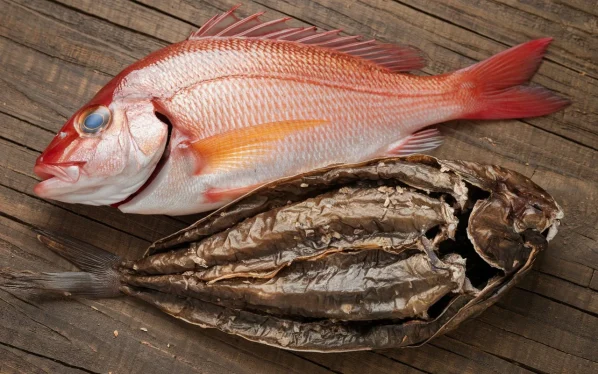- Your cart is empty
- Continue shopping

When it comes to choosing between fresh fish and dried fish, many of us wonder which option is more nutritious. Both types of fish have their own set of benefits and drawbacks, and knowing these differences can help you make better dietary choices.
This article compares the nutritional content of fresh fish and dried fish, answering questions like whether dried fish is more nutritious, its protein content, and whether it’s safe to eat dried fish every day.
Is Dried Fish More Nutritious Than Fresh Fish?
Dried fish and fresh fish both offer unique nutritional profiles. Fresh fish is generally considered to have a higher nutritional value due to its higher content of protein, lipids, and carbohydrates compared to dried fish. However, dried fish has its own advantages, such as a longer shelf life and ease of storage, making it a convenient option for many consumers.
The process of drying fish involves removing moisture, which can lead to a concentration of nutrients per serving. However, this process also involves adding salt, which can increase sodium intake. Additionally, drying can cause some loss of nutrients, especially water-soluble vitamins like vitamin C and B vitamins.
Does Dried Fish Have More Protein?
Dried fish is renowned for its high protein content. In fact, it is one of the richest protein sources among all foods. For every 100 grams of dried fish, you can expect to get about 63 grams of protein, making it an excellent choice for those looking to boost their protein intake. Fresh fish also contains a significant amount of protein, but the concentration is lower compared to dried fish due to its higher water content.
For example, while fresh mackerel/bangda might contain about 19-20 grams of protein per 100 grams, dried fish can offer nearly three times that amount. This makes dried fish a great option for muscle growth and repair, as well as for supporting a healthy immune system.

Fresh Fish vs. Dried Fish: Nutrition Value Comparison
| Nutrient | Fresh Mackerel/Bangda (100g) | Dried Fish (100g) |
| Calories | Approximately 205-305 kcal | Approximately 333 kcal |
| Protein | About 19 grams | About 63 grams |
| Fat | About 12-25 grams | About 33 grams |
| Carbohydrates | 0 grams | 0 grams |
| Sodium | About 89-90 mg | High (varies, often >1000 mg) |
| Cholesterol | About 70-95 mg | Moderate (varies) |
| Omega-3 Fatty Acids | High | Lower than fresh fish |
| Vitamin D | Moderate | Moderate |
| Calcium | Low | Higher than fresh fish |
| Vitamin B12 | High | May vary |
| Selenium | High | May vary |
Notes:
- Fresh Mackerel/Bangda: Nutritional values can vary slightly depending on the type of fish and cooking method. The values provided are approximate.
- Dried Fish: Nutritional values can vary based on the type of fish and drying process. The high sodium content is due to added salt during drying.
- Omega-3 Fatty Acids: While both types contain omega-3s, fresh fish generally retains more due to minimal processing.
- Vitamin B12 and Selenium: These vitamins and minerals are often higher in fresh fish, but can vary in dried fish depending on the type and processing.
Is It Okay to Eat Dried Fish Every Day?
While dried fish is nutritious, it’s essential to consume it in moderation. Dried fish is high in sodium, which can be a concern for those with high blood pressure or cardiovascular issues. If not dried properly, it may also contain contaminants like toxins or heavy metals, posing health risks. Additionally, relying too much on dried fish can affect nutrient balance, so it’s important to include a variety of foods in your diet.
However, if you choose high-quality, safely processed dried fish, incorporating it into your diet a few times a week can be beneficial. It provides essential nutrients like omega-3 fatty acids, which support heart health and cognitive function.
Other Nutritional Considerations
Omega-3 Fatty Acids
Both fresh and dried fish are excellent sources of omega-3 fatty acids, which are crucial for heart health and brain function. However, the drying process might slightly reduce these levels compared to fresh fish.
Calcium and Vitamin D
Dried fish is a good source of calcium and vitamin D, essential for bone health. This makes it a valuable addition to diets lacking these nutrients.
Shelf Life and Convenience
Dried fish has a longer shelf life than fresh fish, making it easier to store and transport. This convenience is particularly beneficial in regions where access to fresh seafood is limited.
Environmental Impact
The environmental impact of dried fish can be lower than that of fresh fish, as it requires less energy for storage and transportation. However, the drying process itself may have environmental implications depending on the methods used.
Health Benefits of Dried Fish
Dried fish is a powerhouse of nutrients, offering various health advantages from muscle growth to heart and bone health. Learn more in our detailed article on complete health benefits of dried fish.
- Supports Muscle Growth: High protein content aids in muscle repair and growth.
- Weight Management: Protein helps keep you full, supporting weight loss efforts.
- Heart Health: Omega-3 fatty acids reduce inflammation and improve cardiovascular health.
- Bone Health: Rich in calcium and vitamin D, essential for strong bones.
- Immune System: Protein supports immune function, keeping you healthier overall.
Both fresh and dried fish have their nutritional advantages. Fresh fish generally retains more nutrients due to minimal processing, while dried fish offers convenience and a concentrated source of protein. Dried fish can be a nutritious addition to your diet when consumed in moderation and sourced from safe suppliers. If you’re specifically interested in prawns, check out our detailed comparison on fresh prawns vs. dried prawns to learn more.
